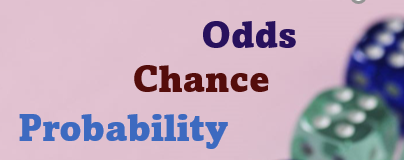Statistics Definitions > Chance vs Probability vs Odds
Probability is the study of the chance something will happen. The two terms—chance and probability—are often used as synonyms. If you’re talking about the chance something will happen, then that is an informal way of saying probability. For example, you might say you have a 10% chance of winning a raffle or you could also say there is a 10% probability you’ll win; they both mean the same thing.
Many other terms are used in the same way: when we say that an event is “likely”, “unlikely”, or “almost definitively” to happen, we are also talking about probability.
Chance vs Probability vs Odds: The Math

Probability is expressed as a percentage from 0% (will never happen) to 100% (will certainly happen). These percentages can also be expressed as a decimal from 0 to 1; to convert a percentage to a decimal, move the decimal point two places to the right. For example, 100.00% becomes 1.00 as a decimal. You can look at a probability as a number that represents the chance or likelihood an event will happen.
Chances are almost always expressed as a percentage; you can think of them as probabilities expressed in a scale “by the hundred”. In other words, the measurement scale for chances and probabilities is different. For example, if the probability of an event happening is 1/4, then the chance of the event happening is 25% (1/4 times 100 percent). Therefore, a chance of 25% literally means that 25 of every one hundred of this particular event would likely happen [1].
Odds is the probability an event will happen, divided by the probability an event will not happen. As a formula:
Odds = p / (1 – p),
where p is the probability (“chance”) of an event happening.
As an example, let’s say you buy a scratch off lottery ticket with stated odds of 1:5 that you’ll win a prize. That means you have one chance of winning vs. five chances of not winning.
To convert odds to probability:
- Place the odds of winning in the numerator of a fraction.
- Place the odds of winning and losing in the denominator.
- Using the above example, odds of 1/5 becomes a probability of 1/(5+1) – 1/6.
You can also convert more without using the formula, if you understand what the odds represents. Odds of 1 to 5 means “one for and five against”. In other words, out of six possible chances (1 + 5), you’ll win once. As a percentage, that’s 1/6; this is our probability. If we put that probability into the formula we get:
Odds = (1/6) / (1 – (1/6)) = (1/6) / (5/6) = 1/5.
Odds are usually not stated in fractional form though; it’s more common to say 1:5 or 1 to 5.
Chance vs Probability vs Odds: References
Fulton, L. et al. (2012). Confusion Between Odds and Probability, a Pandemic? Journal of Statistics Education, Volume 20, Number 3